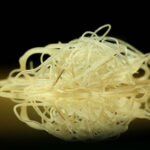Long-haired cats, with their flowing fur and graceful demeanor, often evoke images of elegance and sophistication. These feline beauties can range significantly in size, color, and personality, offering a diverse spectrum for cat lovers to explore. Many long-haired breeds possess distinctive features such as magnificent manes, fluffy tails, charming ear tufts, and endearing toe tufts, adding to their regal appearance. Contrary to popular belief, not all long-haired cat breeds demand extensive grooming routines, making them surprisingly accessible companions.
Let’s delve into some of the most beloved and unique long-haired cat breeds, uncovering their individual charms and care requirements.
Popular Long-Haired Cat Breeds to Adore
1. Persian Cat: The Epitome of Fluffy Elegance
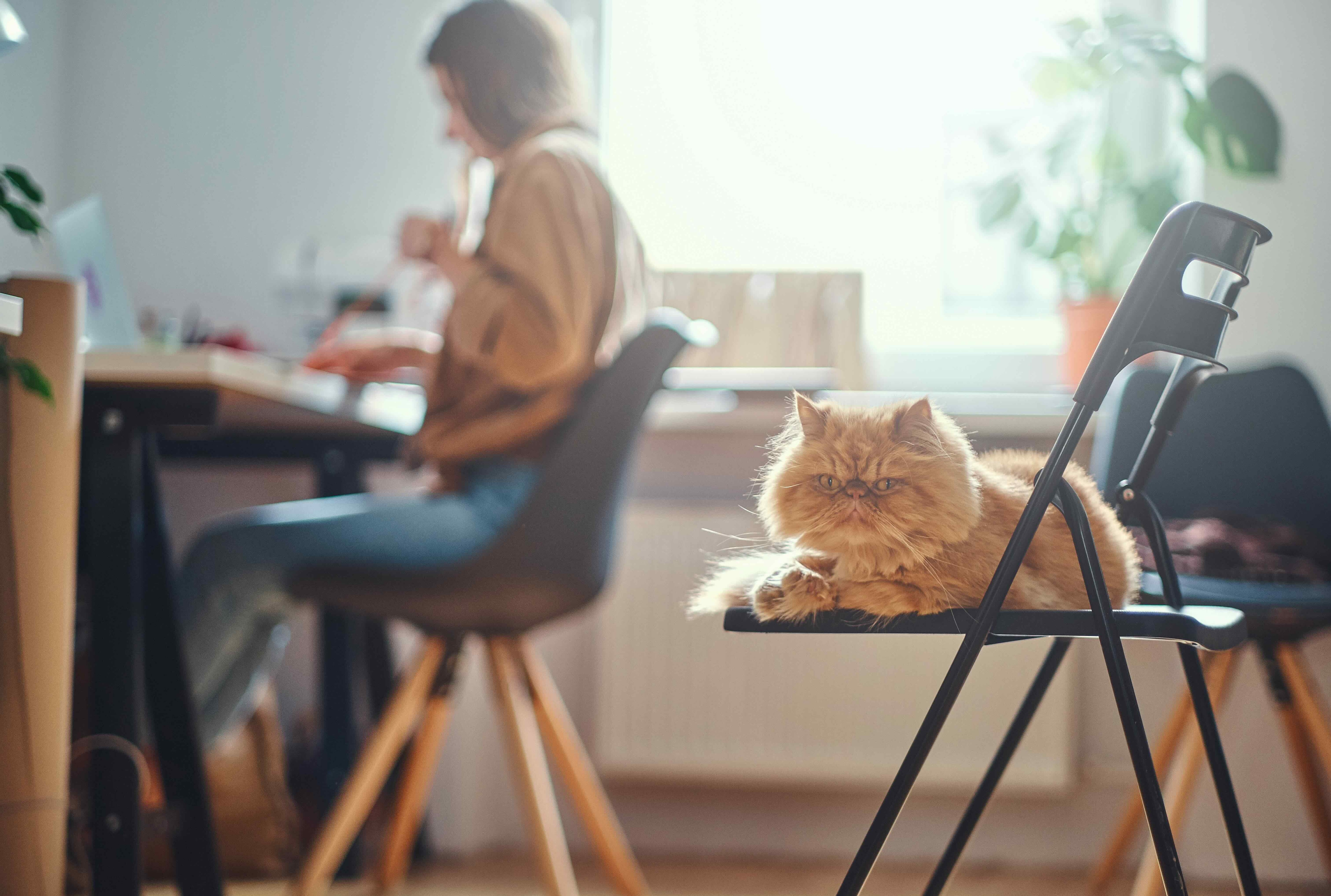 A serene red Persian cat lounges on a chair, with a woman working at a desk in the soft background, highlighting the breed's calm nature.
A serene red Persian cat lounges on a chair, with a woman working at a desk in the soft background, highlighting the breed's calm nature.
The Persian cat breed, instantly recognizable by its luxurious, flowing coat and endearing flat face, stands as one of the most iconic long-haired cats. Renowned for their gentle and mellow personalities, Persian cats thrive in tranquil and peaceful home environments. They are known to form deep bonds with their families, showering them with affection, though they may initially exhibit a reserved demeanor towards unfamiliar faces.
Persians boast a rich palette of coat colors, from classic black, vibrant red, and soft cream, to more unique shades like sophisticated blue and delicate lilac, perfect for those seeking a gray long-haired cat variation. However, their magnificent coats necessitate daily grooming. This routine is crucial to prevent matting and keep their fur and facial area free from debris, ensuring their continued splendor and health.
2. Himalayan Cat: A Playful Blend of Persian Grace and Siamese Charm
 A striking silver colorpoint Himalayan cat sits gracefully in lush green grass, looking upwards, showcasing its distinctive pointed coloring and elegant posture.
A striking silver colorpoint Himalayan cat sits gracefully in lush green grass, looking upwards, showcasing its distinctive pointed coloring and elegant posture.
The Himalayan cat, a delightful and affectionate long-haired breed, is the charming result of crossbreeding Persian and Siamese cats. Easily identifiable by their striking “points”—areas of darker pigmentation on their ears, face (mask), paws, and tail—Himalayans inherit the best traits of both parent breeds.
These points create a beautiful contrast against their generally cream-colored body coat and come in a variety of colors including seal (ranging from black with gold, red, or brown undertones), blue, lilac, chocolate, or flame (a vibrant red-orange). These points can also present in solid colors or various patterns. The Himalayan’s coat texture can range from fine and silky to a denser, wooly feel, but regardless of texture, consistent daily brushing is essential to maintain its beauty and prevent tangles.
3. LaPerm Cat: Uniquely Curly Coated and Endearingly Affectionate
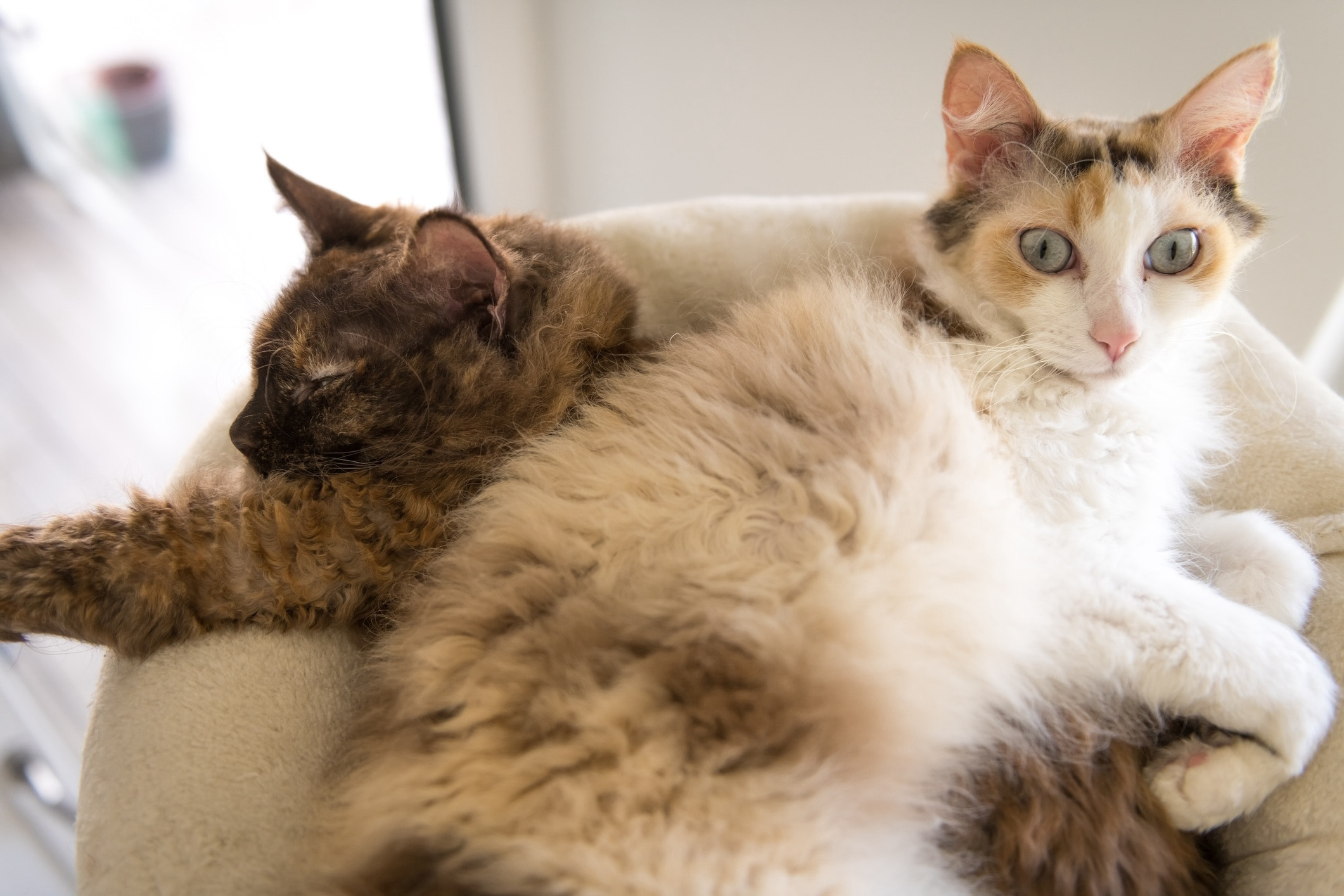 Two playful LaPerm cats curl up together in a cozy cat tree, demonstrating their social nature and distinctive wavy coats.
Two playful LaPerm cats curl up together in a cozy cat tree, demonstrating their social nature and distinctive wavy coats.
Among the most distinctive long-haired cat breeds is the LaPerm, celebrated for its naturally curly coat. This unique wavy appearance is due to a spontaneous genetic mutation. LaPerms can be found in both long-haired and short-haired varieties, each possessing the breed’s signature curls.
The long-haired LaPerm showcases a medium to long coat that can range from loose curls to tight waves, characterized by a springy and airy texture, as described in the Cat Fanciers’ Association (CFA) breed standards. Despite their luxurious long fur, LaPerms are known for being relatively low-shedding and are cherished for their affectionate and energetic personalities, making them wonderful, interactive companions.
4. Maine Coon Cat: The Gentle Giant with a Heart of Gold
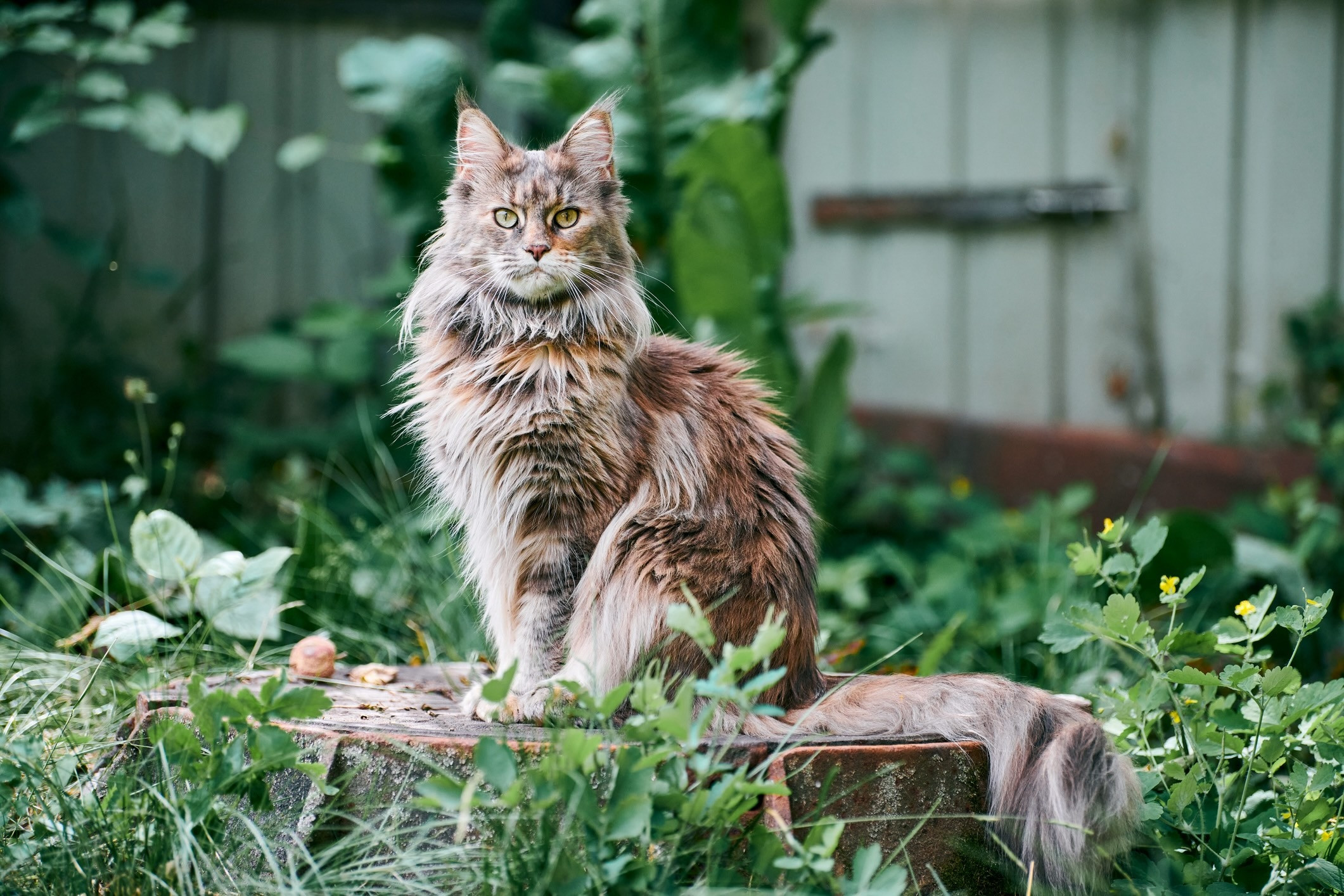 A majestic brown and orange Maine Coon tabby sits regally in a vibrant garden, embodying the breed's large size and love for the outdoors.
A majestic brown and orange Maine Coon tabby sits regally in a vibrant garden, embodying the breed's large size and love for the outdoors.
The Maine Coon, often referred to as the “gentle giant,” is a large long-haired cat breed whose impressive size, coupled with a long, flowing coat and prominent whiskers, creates a truly striking appearance. Renowned for their amiable and intelligent nature, Maine Coons make exceptional family pets. Many exhibit almost dog-like traits, including a playful demeanor and trainability.
As one of the largest domestic cat breeds, a fully grown Maine Coon can weigh up to 25 pounds or even more. Their thick, double coat requires regular brushing several times a week to prevent matting and maintain its healthy, impressive look. This grooming time also provides an excellent opportunity to bond with these sociable felines.
5. Norwegian Forest Cat: The Hardy and Sociable Nordic Beauty
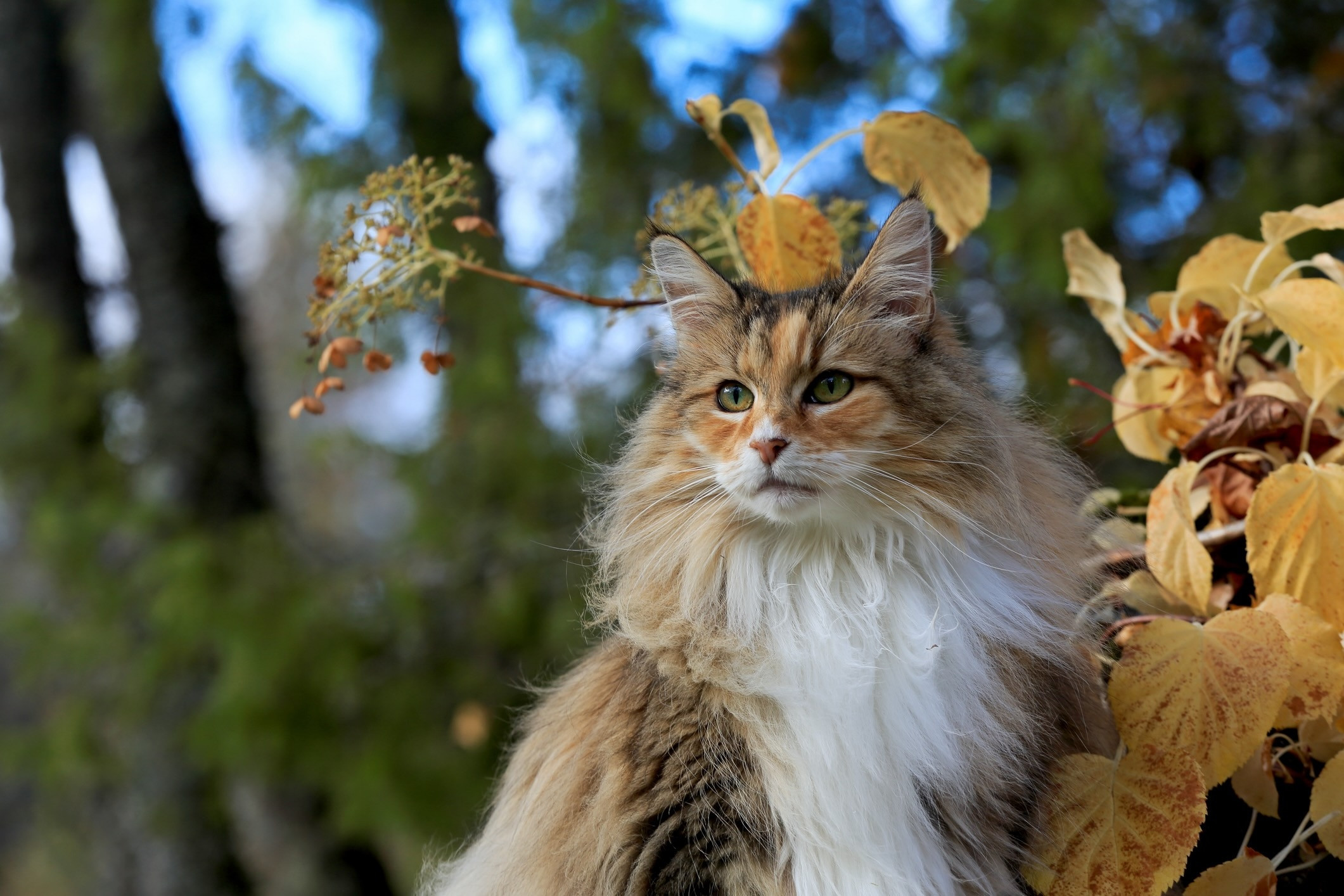 A close-up of a white, brown, and orange Norwegian Forest Cat outdoors, highlighting its thick, weather-resistant coat and alert expression.
A close-up of a white, brown, and orange Norwegian Forest Cat outdoors, highlighting its thick, weather-resistant coat and alert expression.
Another large and strikingly beautiful long-haired breed is the Norwegian Forest Cat. Developed in the harsh Scandinavian climate, these cats boast a dense, water-resistant double coat, perfectly adapted to protect them from cold winters. To keep their magnificent coats in top condition, regular brushing a few times a week is recommended.
Twice a year, during shedding season, Norwegian Forest Cats undergo a significant molt of their undercoat. During these periods, increasing the frequency of brushing becomes essential to manage shedding and prevent fur from becoming unmanageable. Their sociable and affectionate nature typically makes grooming sessions a pleasant experience, as these cats enjoy spending quality time with their human families.
6. Ragdoll Cat: The Relaxed and Affectionate Gentle Giant
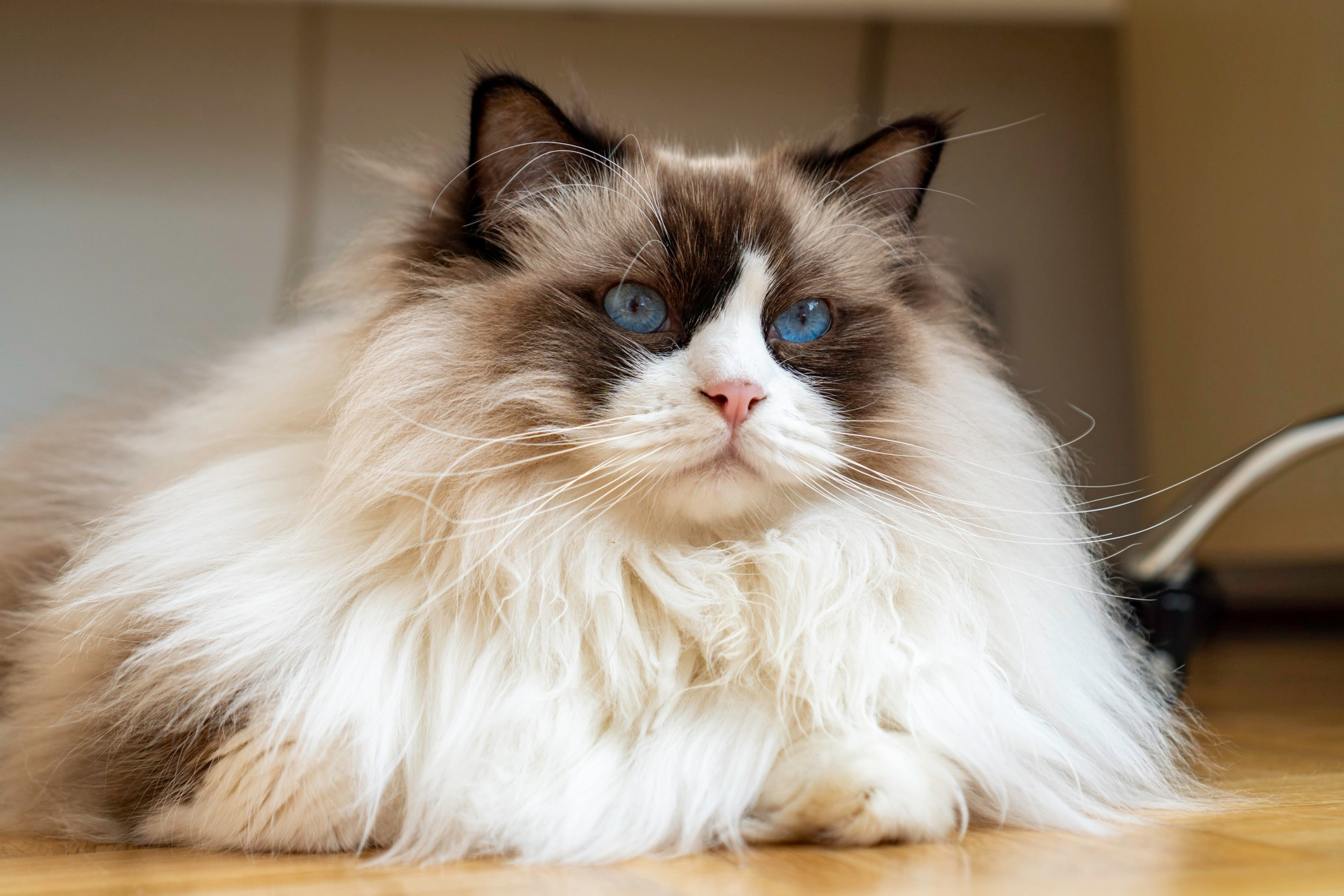 A close-up shot of a serene long-haired Ragdoll cat lying comfortably on the floor, showcasing its relaxed demeanor and soft, flowing coat.
A close-up shot of a serene long-haired Ragdoll cat lying comfortably on the floor, showcasing its relaxed demeanor and soft, flowing coat.
The Ragdoll breed is beloved for its exceptionally docile and affectionate temperament. They earned their name from their tendency to go completely limp and relaxed when held, much like a rag doll. This breed thrives on companionship and is known to be one of the friendliest cat breeds, making them ideal for families and individuals seeking a loving and interactive pet.
Ragdolls flourish in environments where they receive plenty of attention, whether from human family members or other pets. Aside from their need for social interaction, their grooming needs are relatively straightforward. Brushing once or twice a week is generally sufficient to keep their silky coats healthy and free of mats.
7. RagaMuffin Cat: Sweet-Natured and Family-Oriented
The RagaMuffin, closely related to the Ragdoll, is equally celebrated for its exceptionally sweet and affectionate personality. This long-haired cat breed is renowned for forming deep and lasting bonds with their human families, often becoming devoted companions. RagaMuffins possess a plush, soft, and silky coat, characterized by a distinctive ruff around the neck and slightly longer fur on their bellies, contributing to their cuddly appearance.
Despite their luxurious-looking coat, RagaMuffins are surprisingly low-maintenance in terms of grooming. Typically, a weekly combing session is all that is needed to keep their coat in excellent condition and minimize shedding.
8. Siberian Cat: Hypoallergenic and Playful with a Triple Coat
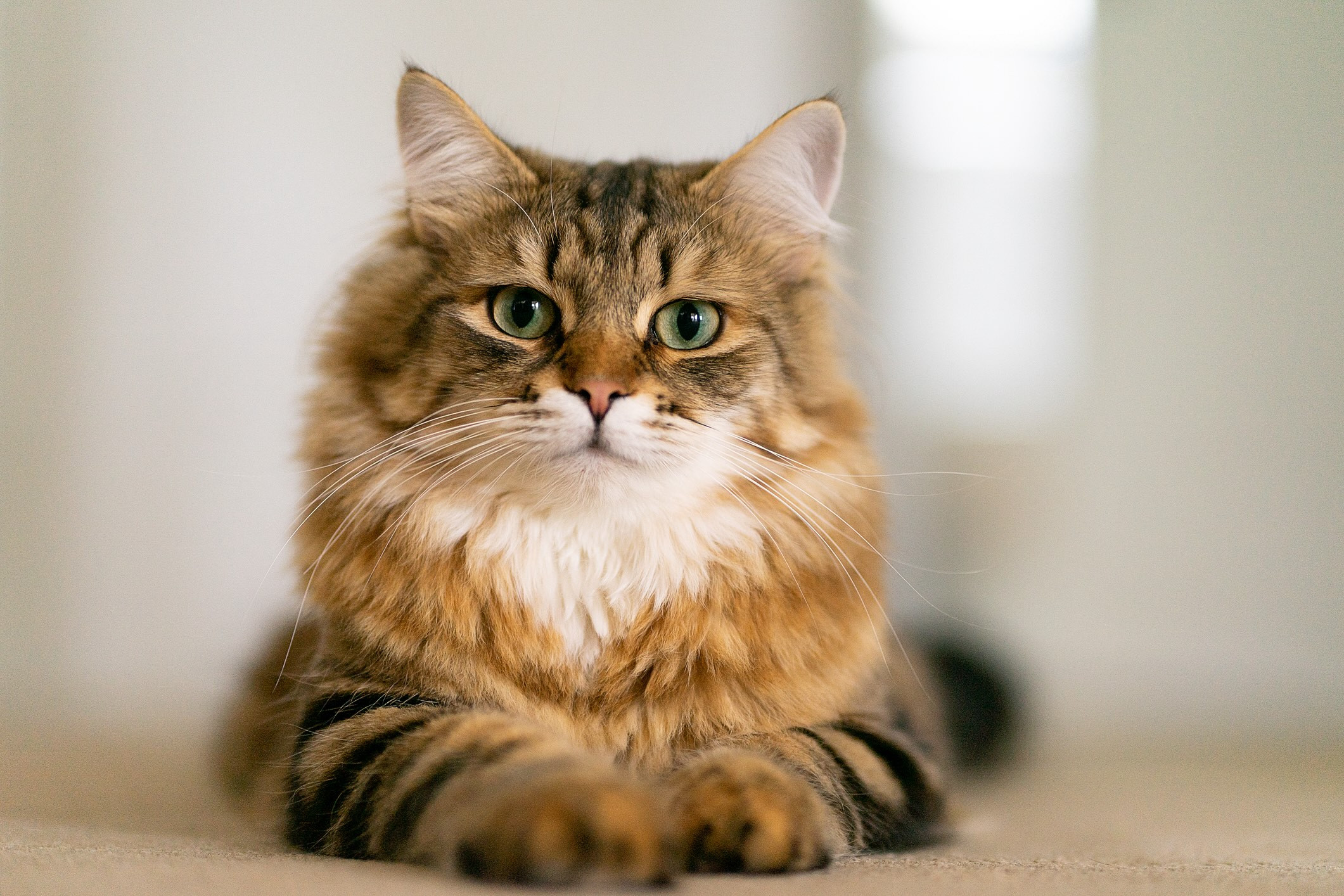 A brown tabby long-haired Siberian cat lies comfortably, looking directly at the camera, highlighting its friendly gaze and lush, triple-layered coat.
A brown tabby long-haired Siberian cat lies comfortably, looking directly at the camera, highlighting its friendly gaze and lush, triple-layered coat.
Compared to other long-haired breeds, the Siberian cat stands out with its unique triple coat, consisting of guard hair, awn hair, and a dense undercoat, designed to withstand harsh Siberian winters. Despite this abundant fur, their grooming needs are surprisingly manageable. Weekly brushing is usually sufficient for most of the year.
However, during the spring and fall shedding seasons, Siberian cats require more frequent grooming, potentially daily, to manage the molting undercoat and prevent matting. Siberians are also known for being hypoallergenic for some individuals with cat allergies, and are famously friendly, intelligent, active, and trainable, often seeking out lap time and interactive play.
9. Selkirk Rex Cat: The Curly-Haired Charmer with a Plush Coat
The Selkirk Rex is distinguished by its naturally curly coat, a trait inherited from a genetic mutation. Their long, fluffy fur is a legacy of their Persian ancestry in the breed’s development. Unlike many long-haired cat breeds, the Selkirk Rex requires a gentler approach to grooming. Over-brushing can disrupt their curl pattern and lead to frizziness.
These fluffy cats benefit from semi-regular bathing as they are prone to developing oily skin. Establishing a gentle brushing and bathing routine early in their life is recommended to ensure they remain comfortable and cooperative during grooming sessions.
10. American Bobtail Cat: Adaptable and Playful with a Wild Appearance
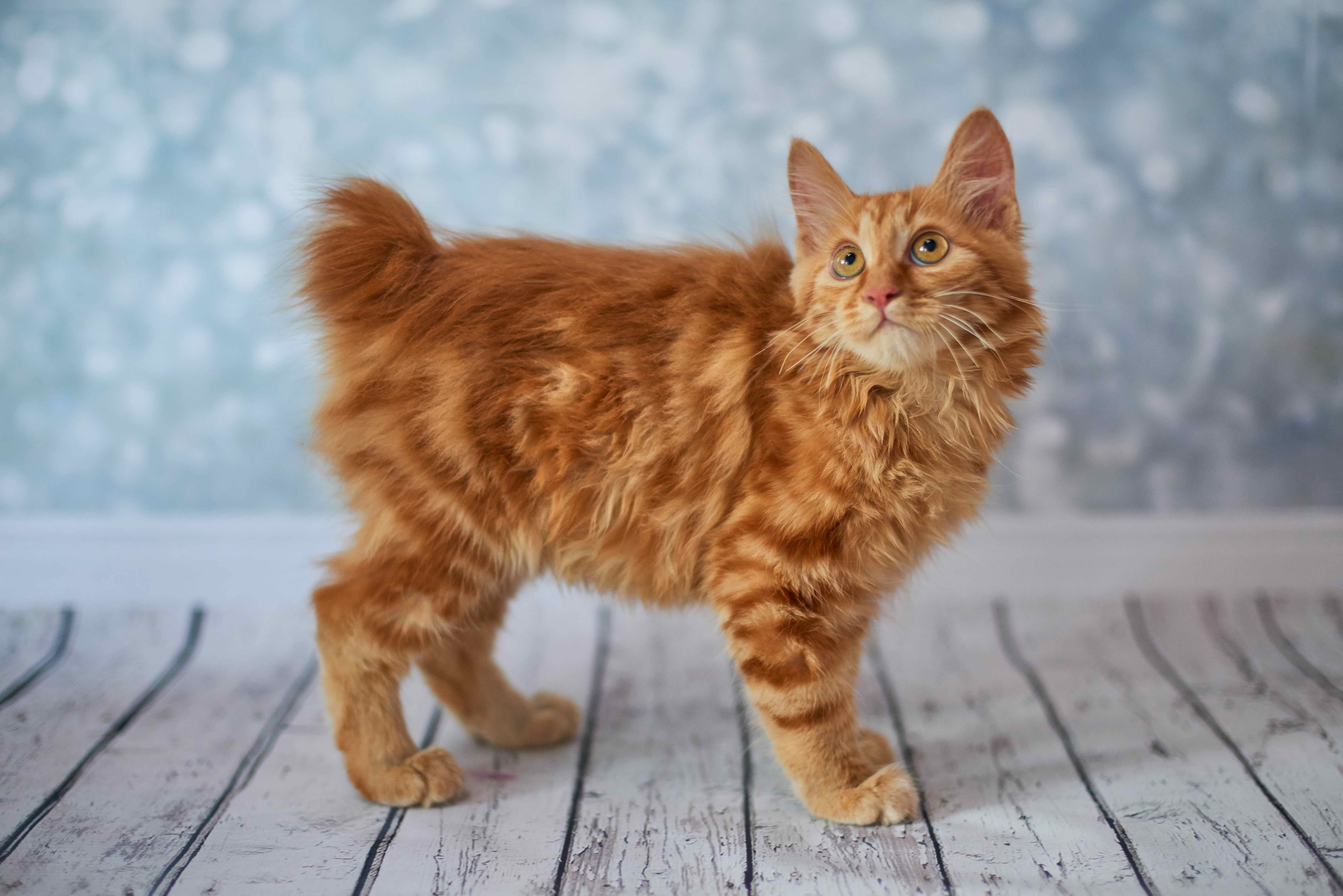 A fluffy red American Bobtail kitten playfully poses, highlighting its shaggy coat and characteristic short, bobbed tail.
A fluffy red American Bobtail kitten playfully poses, highlighting its shaggy coat and characteristic short, bobbed tail.
The American Bobtail cat is characterized by its shaggy, medium-long coat and, most notably, its short, bobbed tail, which can range from just an inch to several inches in length. This breed comes in all coat colors and patterns, meaning you can find an American Bobtail in any shade, from a fluffy brown cat to a striking long-haired orange cat.
According to The International Cat Association (TICA) breed standards, the American Bobtail is a medium-sized, adaptable, and affectionate breed. They are known for their playful nature and intelligence, often enjoying learning tricks and participating in games, making them engaging and interactive pets.
11. Birman Cat: Sapphire Eyes and a Silky, Low-Maintenance Coat
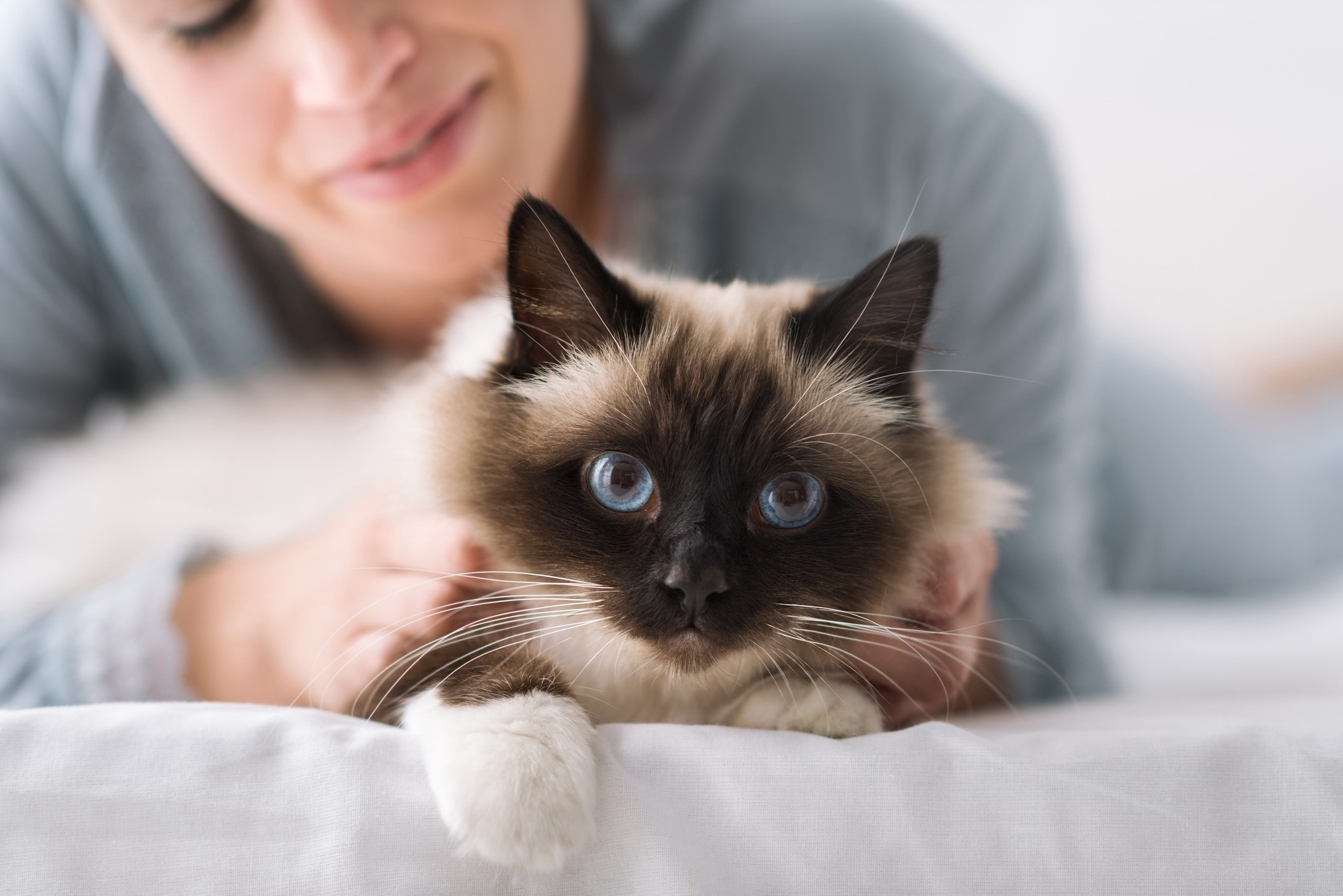 A captivating Birman cat with striking blue eyes is being petted on a bed, looking directly at the camera, emphasizing its beautiful eyes and affectionate interaction with humans.
A captivating Birman cat with striking blue eyes is being petted on a bed, looking directly at the camera, emphasizing its beautiful eyes and affectionate interaction with humans.
The Birman cat, with its brilliant blue eyes and a striking coat of white or cream accented by colored points on the face, tail, and legs, is a truly captivating long-haired breed. They offer a welcome relief to owners concerned about demanding grooming routines, as their long, silky coat is less prone to tangling and matting compared to some other fluffy breeds.
While relatively low-maintenance, regular brushing a few times a week is still beneficial for a Birman. This helps to minimize shedding and reduce the occurrence of hairballs, keeping both your cat and home cleaner and more comfortable.
12. Japanese Bobtail Cat: Energetic and Vocal with a Unique Pom-Pom Tail
The long-haired Japanese Bobtail cat is known for its distinctive pom-pom tail, which is naturally short and flexible, no longer than 3 inches. Their medium to long coat is silky smooth, lacking a dense undercoat, which makes it relatively easy to care for. Weekly brushing is typically sufficient to maintain their elegant coat. Japanese Bobtails come in a wide array of colors, including solid shades, bi-color, and tri-color patterns, offering a diverse visual appeal.
Japanese Bobtails are highly interactive and communicative cats, often vocalizing to get attention and readily befriending new people. They are known for their energetic and playful personalities, making them engaging companions.
13. Pixiebob Cat: The Wild Look with a Domestic Heart
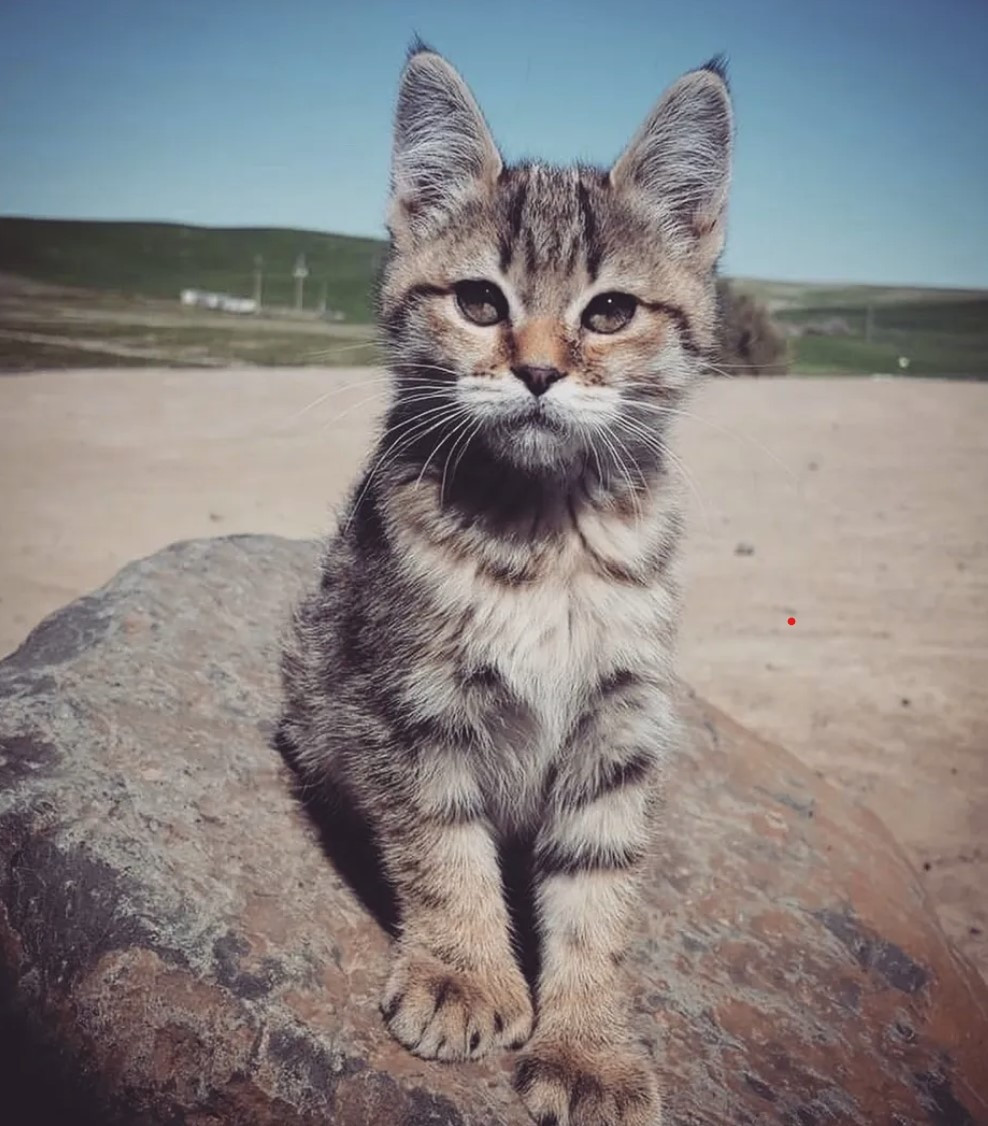 A charming Pixiebob kitten with extra toes sits inquisitively, looking at the camera, highlighting its bobcat-like appearance and polydactyl paws.
A charming Pixiebob kitten with extra toes sits inquisitively, looking at the camera, highlighting its bobcat-like appearance and polydactyl paws.
The Pixiebob breed is intentionally bred to resemble the wild North American bobcat, capturing a rugged, natural look in a domestic cat. The breed standard recognizes both short-haired and long-haired Pixiebobs, both sharing full and bushy facial hair that contributes to their wild appearance.
Long-haired Pixiebobs have a soft coat that is approximately 2 inches long and lies close to the body. Despite their wildcat resemblance, Pixiebobs are known for their relaxed and friendly nature, making them excellent house pets who bond strongly with their families.
14. Turkish Angora Cat: Silky Smooth and Playfully Independent
 An elegant black Turkish Angora cat gracefully lies down against a dark background, showcasing its sleek, silky coat and refined features.
An elegant black Turkish Angora cat gracefully lies down against a dark background, showcasing its sleek, silky coat and refined features.
The Turkish Angora cat boasts a stunningly smooth and silky coat that is as beautiful as it is easy to care for. Lacking an undercoat, Turkish Angoras are less prone to matting, though regular brushing a few times a week is still recommended to keep their coat in prime condition.
While not known for being overly cuddly, Turkish Angoras are highly playful and enjoy interactive sessions with people and other pets. They are also known to be quite vocal, expressing their needs and desires with a variety of meows and chirps.
15. Turkish Van Cat: The Water-Loving Swimmer with a Seasonal Coat
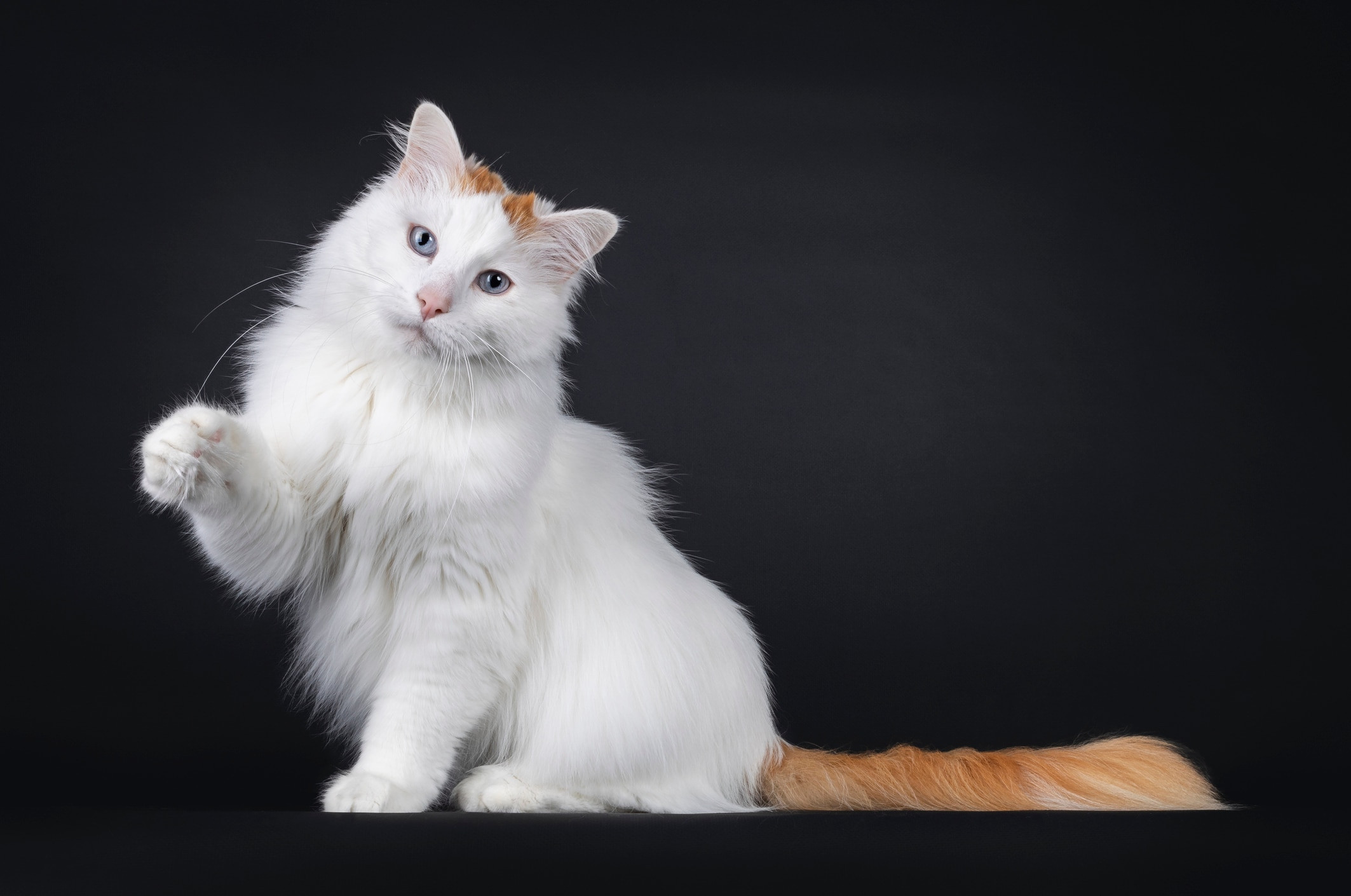 A striking white and orange Turkish Van cat stands alertly on a black background, displaying its distinctive color pattern and robust build.
A striking white and orange Turkish Van cat stands alertly on a black background, displaying its distinctive color pattern and robust build.
Another relatively low-maintenance long-haired breed is the Turkish Van. Interestingly, Turkish Van kittens are born with short coats that gradually develop into their signature long fur as they mature, typically reaching full coat development by 3-5 years of age.
The Turkish Van’s coat is also seasonal; it becomes shorter in the summer and thicker and longer in the winter, adapting to temperature changes. Throughout the year, however, Turkish Vans maintain a full, bushy tail and charming ear tufts, adding to their distinctive appearance. They are also known for an unusual trait among cats: a love for water, often enjoying swimming and playing in water.
Essential Care for Long-Haired Cat Breeds
Generally, the care requirements for long-haired cats are similar to those of any cat. They need a balanced diet with proper nutrition, plenty of mental stimulation through play and interaction, and essential provisions like a clean litter box and engaging cat toys. However, long-haired cat breeds typically require more attention when it comes to grooming to manage their abundant fur.
The most crucial aspect of caring for long-haired cats is regular brushing and routine nail trimming. Investing in a quality comb and brush designed for long fur is essential for removing loose hair, preventing dander buildup, and keeping their coats smooth and tangle-free.
Learning the correct techniques for brushing a cat is important, and making grooming a positive experience through gentle handling, affection, and rewarding treats throughout the session can make it easier for both you and your cat. However, it’s important to avoid over-brushing, as this can lead to frizzy or broken hairs.
For stubborn mats that are difficult to remove, seeking professional help from a groomer is advisable. In fact, some very fluffy breeds like Persians and Siberians may benefit from regular professional grooming. A groomer can provide thorough brushing, detangling, and even trims to simplify at-home maintenance and keep your long-haired feline looking and feeling their best.
WRITTEN BY
Erica Puisis
Freelance Writer

